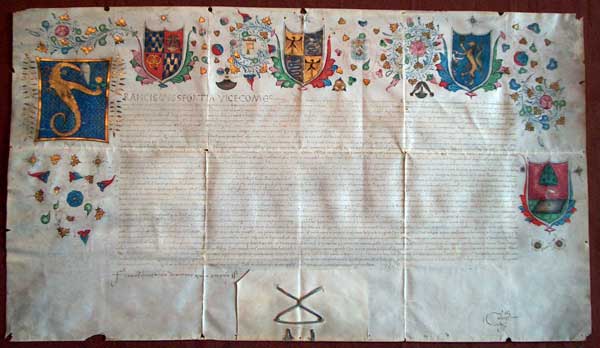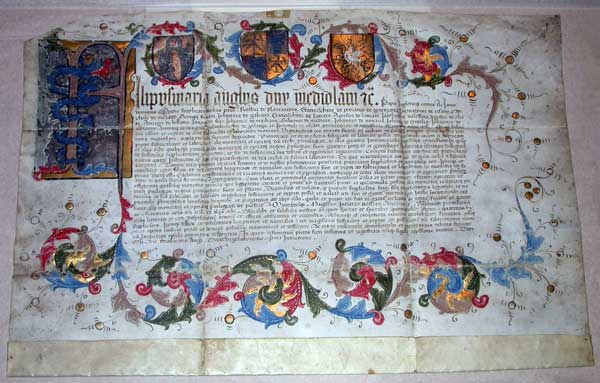
Founding Act of the Ospedale Maggiore in Milan by Francesco Sforza, April 1, 1456
The archive contains all the administrative documents produced or received from the
Ospedale Maggiore, from its inception, the series begin with the parchements relating
to hospitals medieval Dukedom of Milan and its aggregates in the mid fifteenth century, until today.
Here we hedge all the documents that concerns the administration, accounting, personnel, construction
and maintenance of hospital buildings, purchases, contracts and procurement, property management in cities
and in Lombardy, and the correspondence of medical direction. There are not however preserved the health
records, except for the registers of admissions from 1899 to 1972.
Hospital archives in the strict sense alongside individual funds relating to institutions, corporations
or pious legacies administered by the hospital, in addition to those produced by offices or emanations
of the hospital or residual entities managed in the past.
Over the centuries, the Hospital has acquired a vast property portfolio, extended to the whole of Lombardy,
documented in the archives of ecclesiastical or feudal estates united and increased thereafter, as well as
private archives or documents arising from individual donations and legacies of benefactors that over time
helped the body. The overall development of the racks is approximately 3,000 linear feet.
The management of the increase of physiological storage section and requests for consultation by the
Office of scholars and is coordinated by the Cultural Service of the Hospital.
Ordinamento
The feature of document management at the Hospital is the practice of planting Registratur
Austrian and German, still popular and respected in other hospitals or healthcare in Milan and
Lombardy. Another feature is an improved classification schema the late eigtheenth century.

Diploma of Filippo Maria Visconti, August 13, 1423
The Archive currently consists of:
- The historical section, created in the early twentieth century, including the documentation from the foundation up year 1863, is full of about 5,000 folders, 3,600 books, 700 maps, and also includes archives aggregates of existing hospitals and the ancient Duchy of Milan.
- In the historical section, are joined, now divorced from the original backgrounds, diplomatic collections: Diplomas, Codes, Autographs, Residues of archives inherited, with documents dating from the eleventh century, 16,000 scrolls, sometimes full of miniatures and provided with seals and a significant historical importance.
-
The "administrative" section includes documents produced after 1863 (up to the historic 1967); it maintains
more than 10,000 folders of documentation on the life of the Hospital of the nineteenth and twentieth centuries.
Of particular note papers we have the ones related to the building of the Niguarda Hospital and other Hospitals: Sesto S.G., San Carlo. - The archive storage, for the practiceses depleted less than 40 years ago which are still indispensable nowaday to the administration because of their value.
- The oldest part of the archives of the Psychiatric Hospital of Senavra (1780-1866), the Pia Casa S. Caterina alla Ruota (1780-1866), Congregazione di CaritÓ (1808-1825), and residual bodies administered in the past: O.P. Santa Corona (1930-1949), Sanatorium Garbagnate (1941-1942).
- The funds, products, services or emanations from the same hospital: the Medical Management Archives (White Archive 1796-1827, and Red Archive 1828-1861), the archives of Country Agencies (Bertonico, Fallavecchia, Brianza), the nurses school (1931-1991), the Visitors Commission (1900-1993).
- The archives of pious bequests and charitable organizations founded by benefactors and administered by the hospital itself: Macchio (1797-1951), Del Sesto (1801-1966), Secco Comneno (1830-1873), Ponti (1892-1950), Paravicini (1894-1953), Antirabico (1886-1993). Archives themselves are small funds: the Association of Hospitals Lombardi - Adol (1946-1988), National Association of Italian Hospitals - Anoi, Lombardy Section (1935-1945), and private archives received with a legacy of families (including the most important of which is the Archive Litta Visconti Borromeo Arese family).

 Versione italiana
Versione italiana